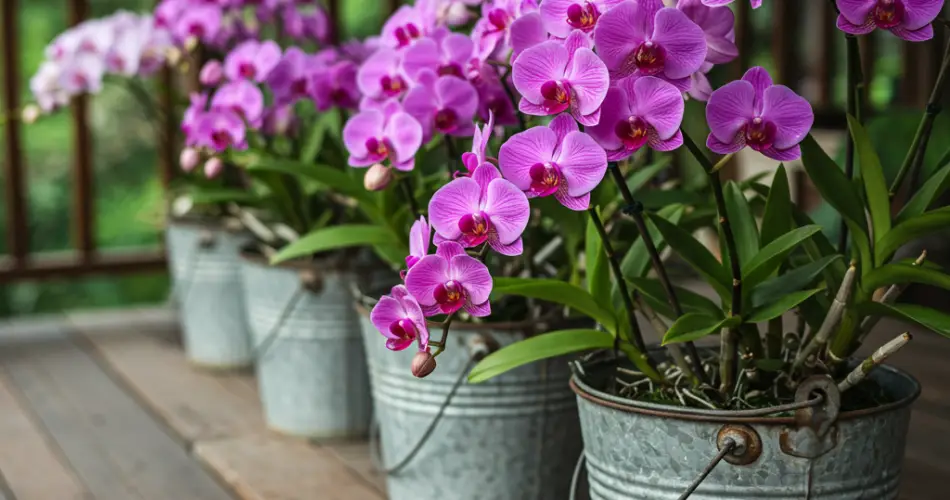Growing orchids may seem like a task best left to expert gardeners, but with the right approach, anyone can cultivate these exotic beauties—even in a simple bucket. While orchids aren’t typically associated with food gardens, they reward you with striking, long-lasting flowers that bring a tropical feel to your home. Whether you’re a beginner or a plant enthusiast looking to try something new, growing orchids in buckets is an accessible and rewarding method.
Here’s how to successfully grow orchids in buckets and enjoy their elegant presence right at home.
1. Choose the Right Orchid Variety
There are thousands of orchid species, but for home growing in buckets, the best choices are epiphytic varieties. These include:
-
Phalaenopsis (Moth Orchids): Ideal for beginners, known for their long-lasting flowers.
-
Dendrobium: These orchids have tall, cane-like stems and come in a range of vibrant colors.
-
Cattleya: Famous for their large, fragrant flowers.
Choose healthy plants from reputable sources. Look for firm green leaves, sturdy roots, and no signs of rot or pests.
2. Selecting the Bucket
You don’t need an expensive pot to grow orchids—any clean plastic or decorative bucket will do. However, it’s important to modify it for proper drainage and aeration:
-
Drill several holes at the bottom and sides of the bucket to prevent water buildup.
-
Choose a size that comfortably fits the root system, leaving just a bit of space for growth.
-
Use a shallow container for orchids like Phalaenopsis, which don’t need deep roots.
You can also place the bucket inside a decorative cover pot for aesthetics and easier handling.
3. Use the Right Potting Medium
Orchids do not grow well in regular potting soil. Instead, they need a growing medium that provides both support and good air circulation. A proper mix includes:
-
Orchid bark or coconut husk chips
-
Sphagnum moss (optional, to help retain some moisture)
-
Perlite or charcoal for drainage
This kind of mix mimics the natural environment where many orchids grow—clinging to trees rather than rooting in soil.
4. Lighting Conditions
Orchids need bright, indirect sunlight to thrive. Place the bucket near an east- or north-facing window or shaded area on a balcony. Avoid harsh afternoon sun, which can scorch the leaves.
If you don’t have access to good natural light, consider using grow lights. Position the lights about 12 inches above the plant and leave them on for 12–14 hours a day.
5. Watering Wisely
Overwatering is a common mistake with orchids. They prefer a cycle of watering and drying. A general rule:
-
Water once a week during cooler months.
-
Increase to twice a week in warmer seasons or if humidity is low.
Water early in the day, allowing time for moisture to evaporate from the leaves and roots. Use lukewarm, distilled, or rainwater when possible, as orchids are sensitive to salts and chlorine in tap water.
6. Humidity and Airflow
Orchids thrive in 50–70% humidity. If your home is dry:
-
Mist the leaves with water daily (avoiding the flowers).
-
Place a humidity tray (a shallow tray filled with pebbles and water) under the bucket.
-
Use a small fan nearby to keep air circulating gently around the plant.
Good airflow helps prevent fungal issues and keeps the roots healthy.
7. Feeding and Fertilizing
Orchids benefit from regular, light feeding. Use a balanced, water-soluble orchid fertilizer, diluted to half strength. Apply every two weeks during the growing season (spring and summer) and reduce to monthly in fall and winter.
Remember the rule: “Weakly, weekly.” Too much fertilizer can burn the roots or cause salt buildup.
8. Repotting and Maintenance
Every 1–2 years, repot your orchid when the potting mix breaks down or roots start crowding the bucket. Choose fresh mix and trim any dead roots during the process.
Regularly clean the leaves with a damp cloth and inspect for signs of pests like mealybugs or spider mites. Remove spent flower spikes after blooming to encourage new growth.
9. Encouraging Re-blooming
Getting an orchid to rebloom may require a rest period. After the flowers fall off:
-
Reduce watering slightly.
-
Move the plant to a cooler area (around 60°F or 15°C) for a few weeks.
-
Resume regular care when new leaves or roots appear.
With patience, your orchid will reward you with another cycle of blooms.
Final Thoughts
Orchids may look delicate, but with the right environment and care, they can flourish even in something as humble as a bucket. They offer striking color, unique form, and a sense of tranquility that enhances any space. By choosing the right variety, maintaining light and humidity levels, and watering properly, you can enjoy the exotic beauty of orchids year-round—no greenhouse required.



